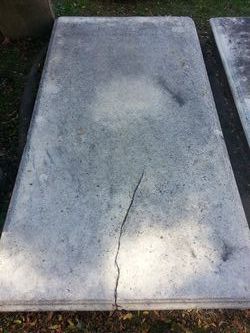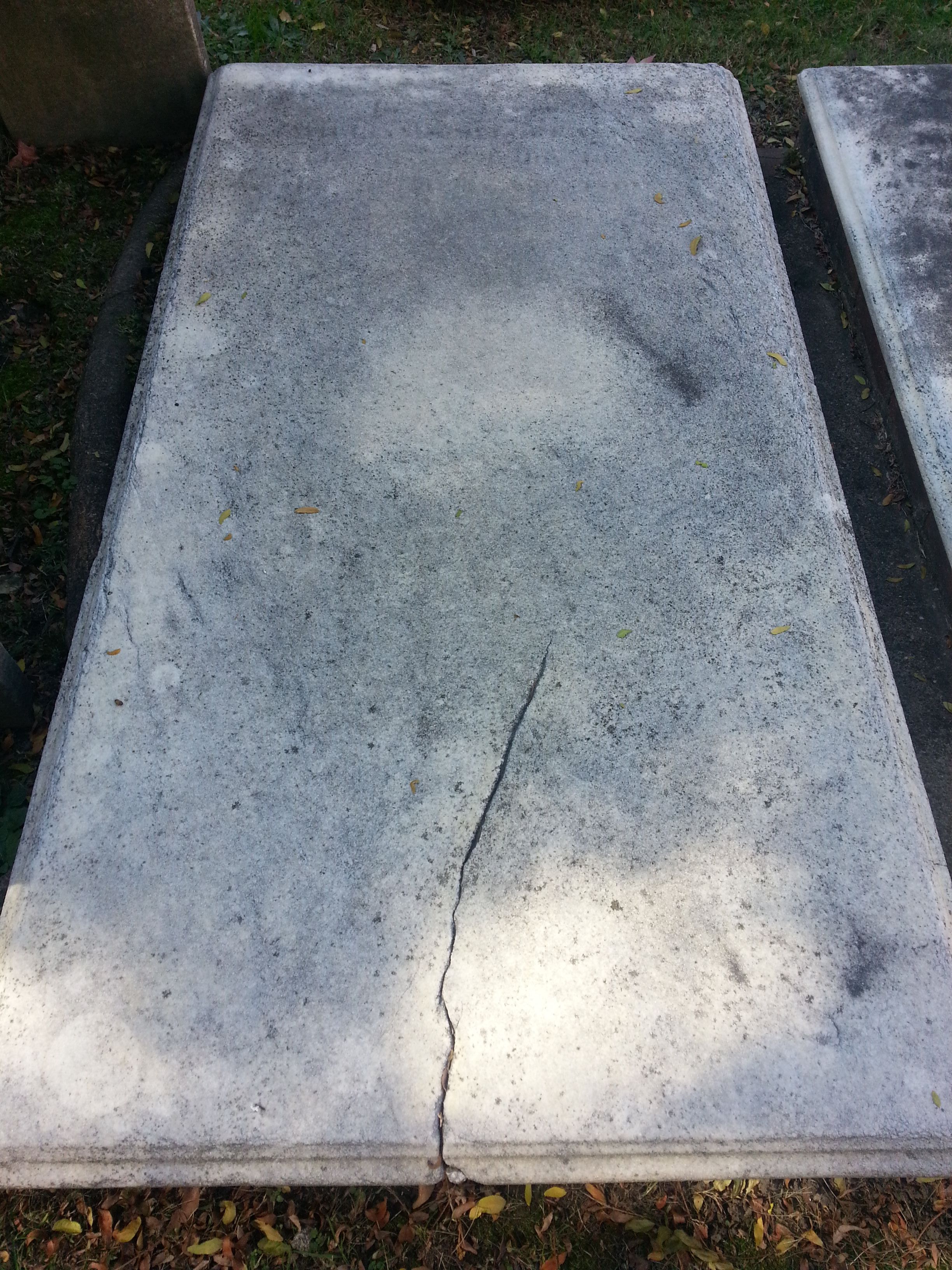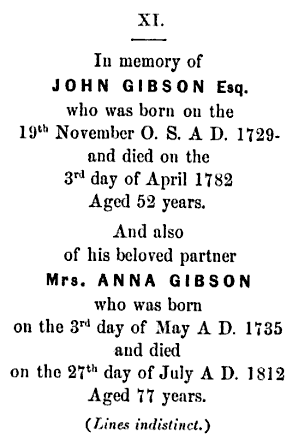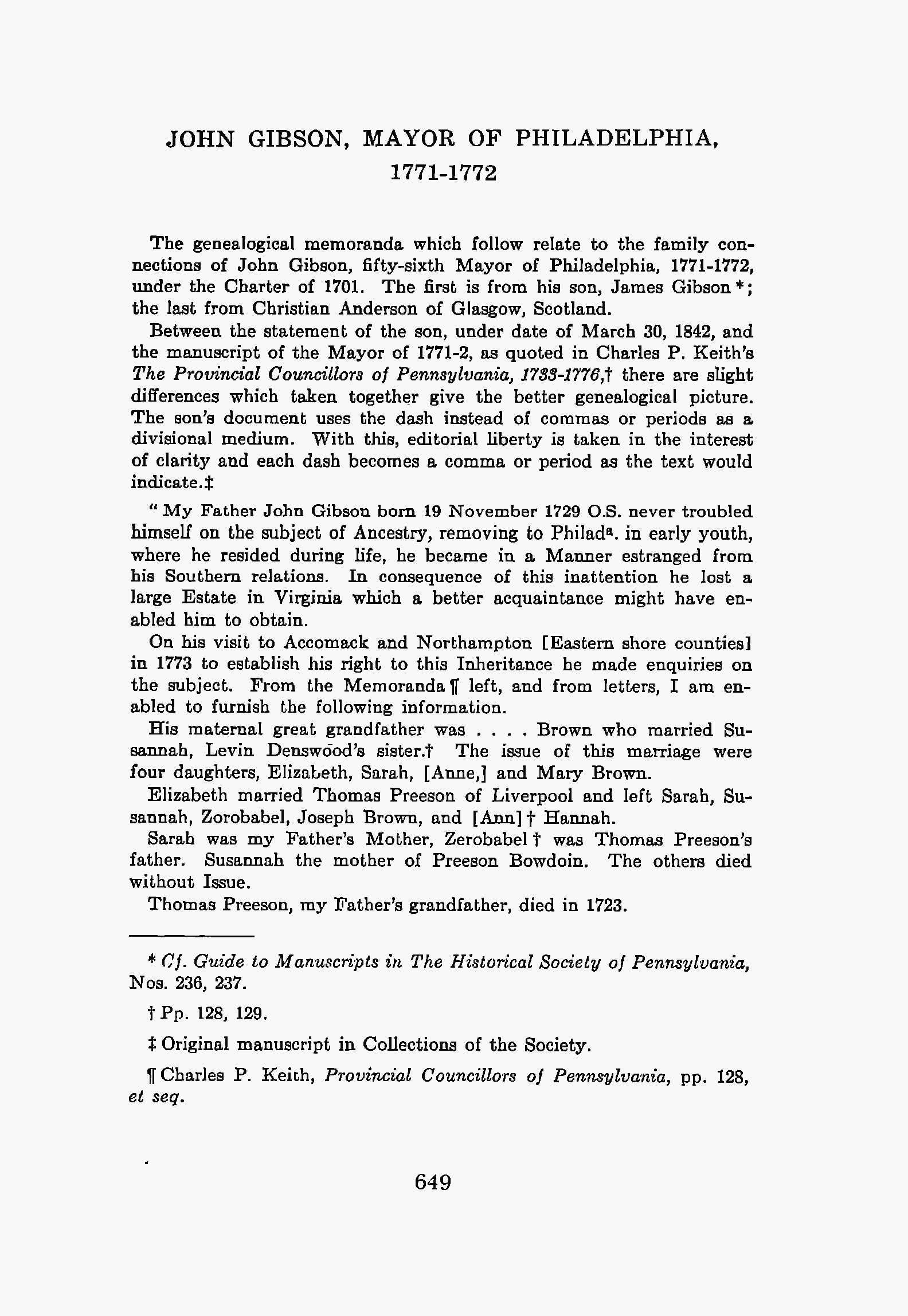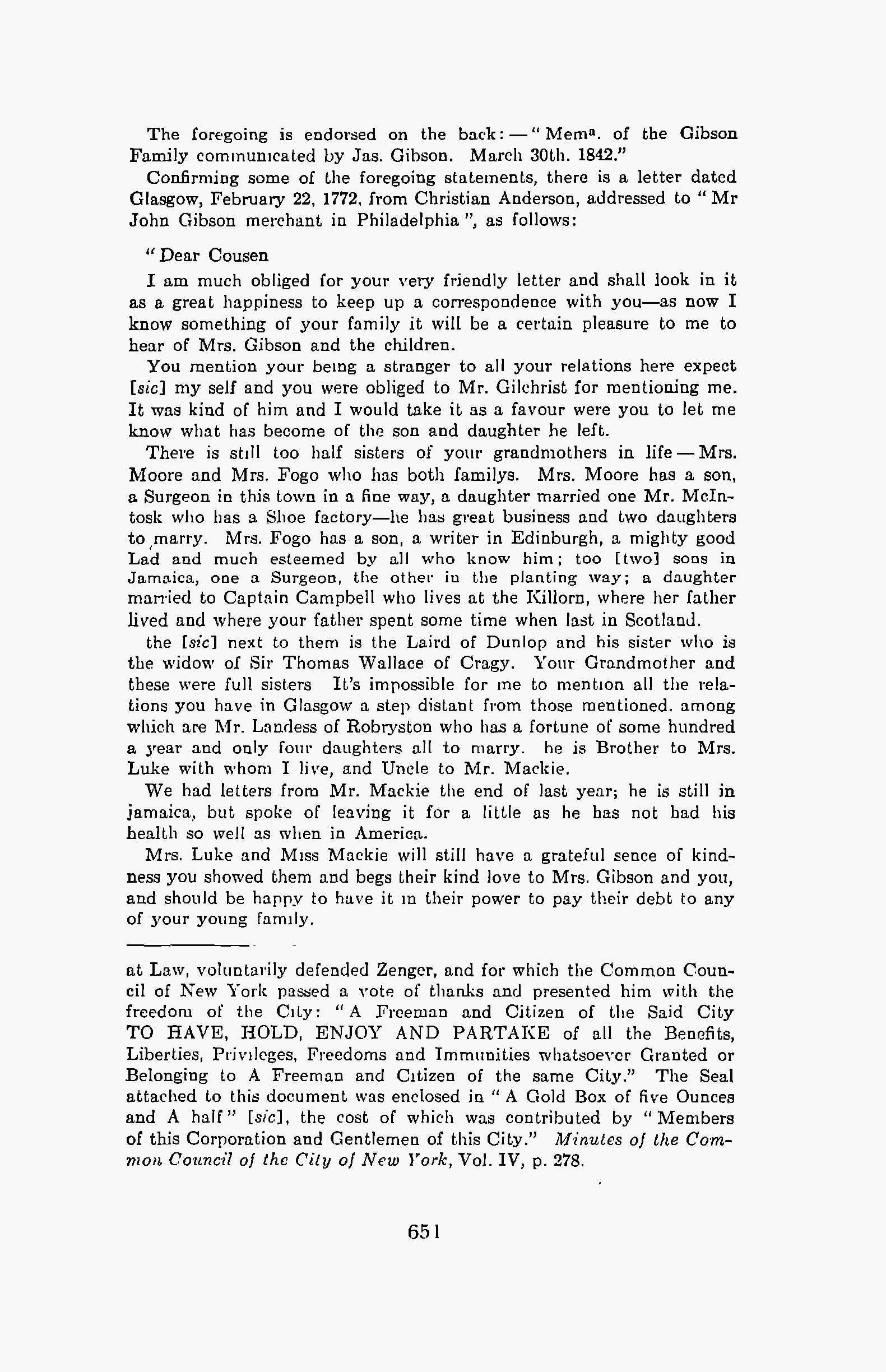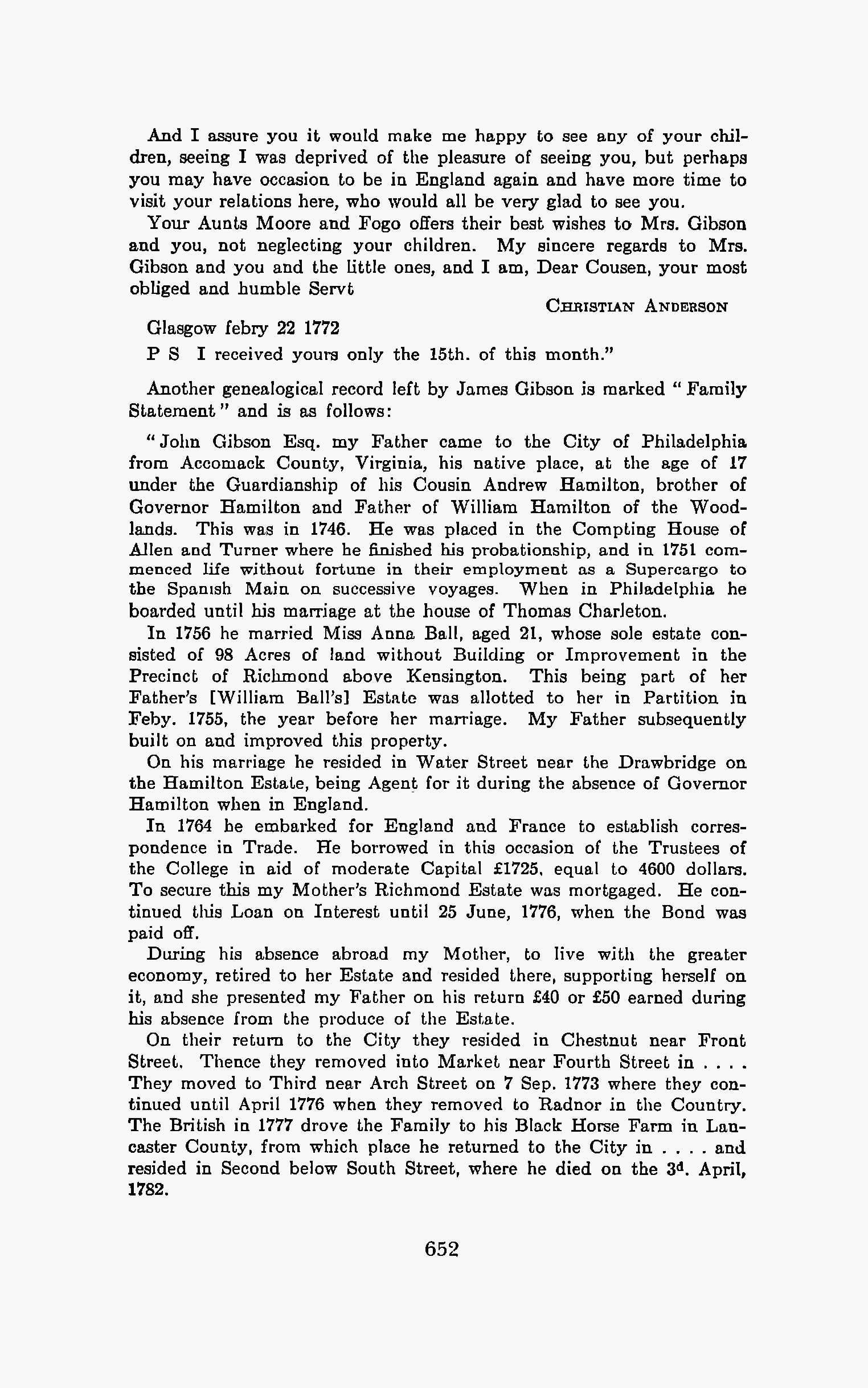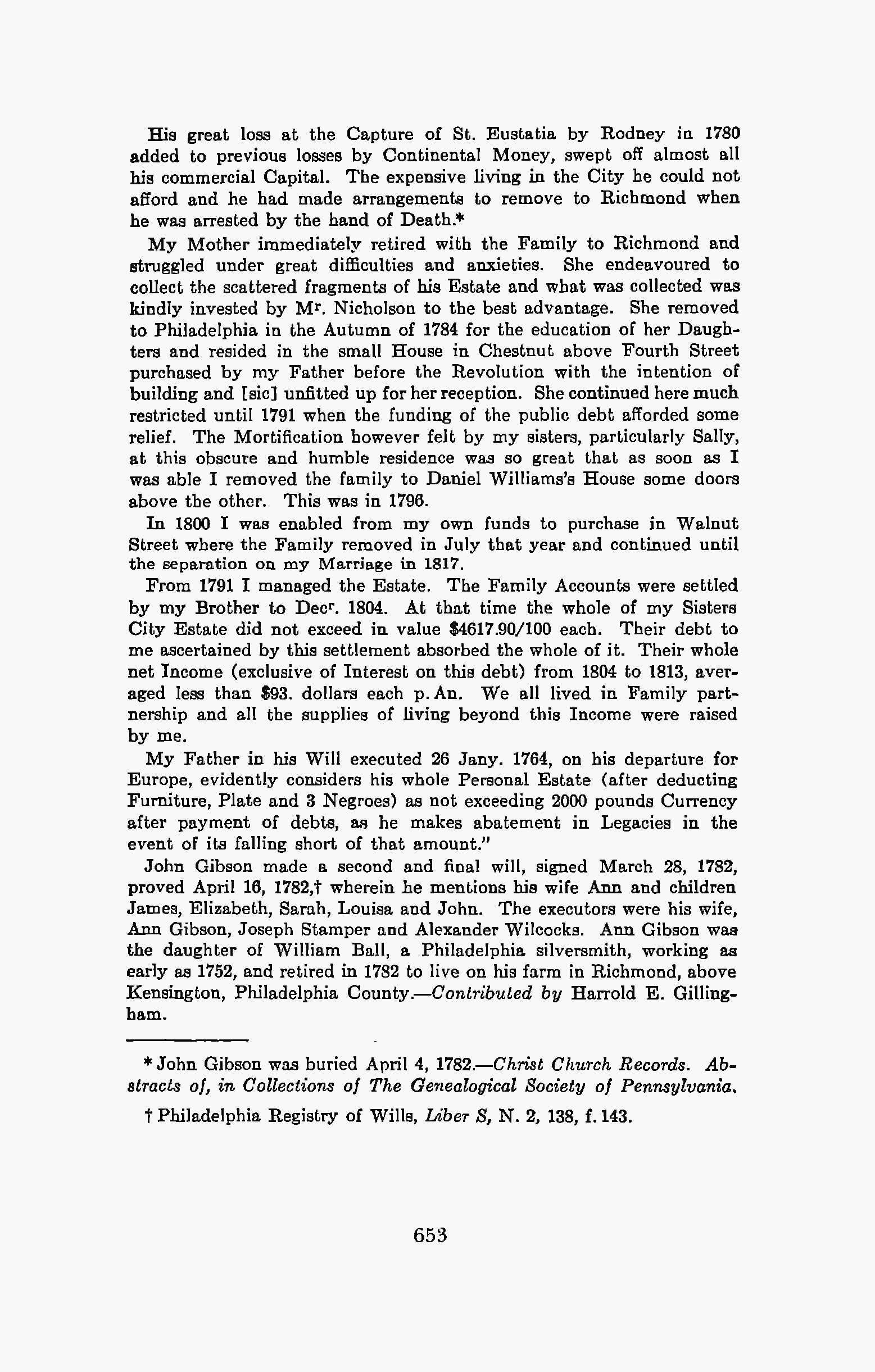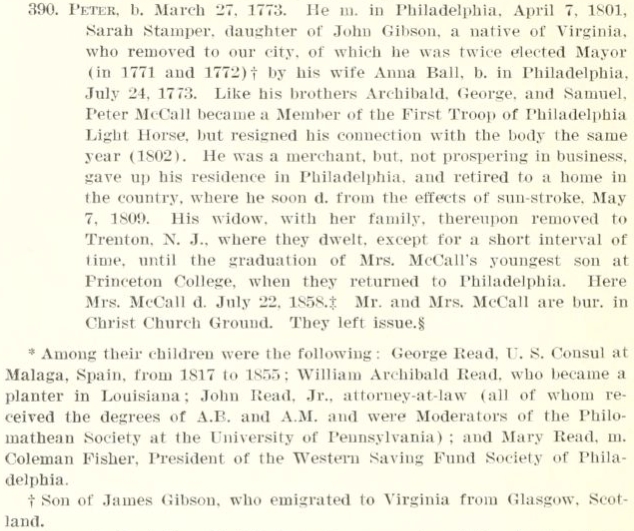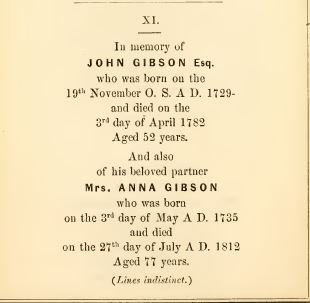Mary Gibson
Thomas Gibson
Frances Gibson
Jean Gibson
George Gibson
Ann Gibson
James Gibson
John Gibson married Anna Ball on October 15, 1757, in Philadelphia, Philadelphia Co., Pennsylvania. Anna Ball was the daughter of William and Mary (White) Ball.
John and Anna's children were:
1) James Gibson, b. 1758, Lancaster, Virginia
2) John Gibson, b. 1760, Lancaster, Virginia
3) Eliza Gibson, b. Abt. 1762
4) Louisa Gibson, b. Abt. 1764, Lancaster, Virginia
5) Sara Stampler Gibson, b. 1766, Lancaster Virginia
Notes for Ann Ball:
Source 1: Will of William Ball, dated 1837.
Source 2: "Ball Cousin Book," p. 331.
Source 3: "Cogswell-Haldeman" by Helen Cogswell Trostel (Big Mountain Press).
Note: The old markers are no more legible in the cemetery. In 1864, Edward L. Clark, the Warden of Christ Church, published "A Record of the Tablets and Grave-Stones in the Burial Grounds of Christ Church, Philadelphia." He explained that he copied the text of all of the stones that were legible, with a second copyist examining the stones to test for correctness. The church records were also consulted to help with any doubts. In this book are the location of the marker and the record of the inscription for John and Anna Gibson and their son John. This record also verifies the John Gibson buried in this cemetery was born in 1729.
Family Information contributed by family member:
Yvette E. (Byrum) Aune
FAG: 47044096
Email: [email protected]
From "Genealogies of Pennsylvania Families," Volume 883:
JOHN GIBSON, MAYOR OF PHILADELPHIA 1771-1772
The genealogical memoranda which follow relate to the family connections of John Gibson, fifty-sixth Mayor of Philadelphia, 1771-1772, under the Charter of 1701. The first is from his son, James Gibson*; the last from Christian Anderson of Glasgow, Scotland.
Between the statement of the son, under date of March 30, 1842, and the manuscript of the Mayor of 1771-2, as quoted in Charles P. Keith's "The Provincial Councillors of Pennsylvania, 1733-1776," there are slight differences which taken together give the better genealogical picture. The son's document uses the dash instead of commas or periods as a divisional medium. With this, editorial liberty is taken in the interest of clarity and each dash becomes a comma or period as the text would indicate it.
"My father John Gibson born 19 November 1729 O.S. [Old Style Calendar] never troubled himself on the subject of Ancestry, removing to Philada [Philadelphia] in early youth, where he resided during life, he became in a manner estranged from his Southern relations. In consequence of this inattention he lost a large Estate in Virginia which a better acquaintance might have enabled him to obtain.
On his visit to Accomack and Northampton (Eastern Shore counties) in 1773 to establish his right to this Inheritance he made enquiries on the subject. From the Memoranda left, and from letters, I am enabled to furnish the following information.
His maternal great grandfather was .... Brown who married Susannah, Levin Denwood's sister. The issue of this marriage were four daughters, Elizabeth, Sarah, (Anne) Hannah.
Elizabeth married Thomas Preeson of Liverpool and left Sarah, Susannah, Zorobabel, Joseph Brown, and (Ann) Hannah.
Sarah was my Father's Mother, Zerobabel was Thomas Preeson's father. Susannah the mother of Preeson Bowdoin. The others died without Issue.
Thomas Preeson, my Father's grandfather, died in 1723.
The Daughters of ..... Brown, who were my Father's grandmother and great Aunts, were connected by marriage with the principal families on the Eastern Shore of Virginia and thus became the maternal Ancestors in (of) the following. Second Marriages were frequent in those days.
Elizabeth Brown was the Maternal Ancestor of Preesons, and Bowdoins of which Governor Bowdoin of Massachusetts, I believe, was a member.
Sarah Brown of the Upshur, Teagle [Teackle] and Scarborough families.
Anne Brown married Joseph Preeson and afterwards Andrew Hamilton. She was the mother of James Hamilton, Andrew Hamilton and Mrs. Allen; her Grand children were Mr. Penn, Mrs. Delany and the sons of William Allen.
Mary Brown married Southey Littleton and afterwards Hancock Custis, and was ancestor to the Littleton, Eyre, Gale and Custis families.
The above outline may be traced in detail through the branches of the above mentioned families beginning at the present period and ascending. John Teagle married Susannah, a daughter of Sarah Brown, and left many Sons. Susannah afterwards married Edmund Scarborough and had a daughter living in 1773.
Levin Denwood left issue who became ancestors in some of the families referred to and perhaps others.
My Father's paternal ancestors were Inhabitants of Glasgow. His great aunt of the half blood was mother of Dr. Moore the traveller, father of General Sir John Moore who fell at Corunna.
The Laird of Dunlop was son of his Grand Mother's sister. The sister of Dunlop married Sir Thomas Walllace of Crogy. My Grandfather James Gibson settled in Virginia.
Franscenia Muir, Widow of Adam Muir who died in 1772, was sister or half sister to my Father and was living in 1781. She was 23 years older than he, being born 24 Sep. 1706. She had 3 Daughters and 3 grandchildren. Her soninlaw Walter Hatton had a son Walter who visited Richmond in 1783.
Andrew Hamilton was born in Scotland; he settled in Maryland in early life at or under 21 years of age. He was well educated and delicately brought up. There was a Mystery attending him and it was supposed Hamilton was an assumed name. It was said he had killed a person in a duel. His Marriage is proof of his standing. He was the first Lawyer of his day in Penna.--first in the Proprietary Council and most influential with him. He represented Bucks County many years--and tried the great Cause in New York in 1722 against a Printer prosecuted by the Government*. Reported in Hargraves State trials.
The foregoing is endorsed on the back: --"Mema. of the Gibson Family communicated by Jas. Gibson. March 30th. 1842."
Confirming some of the foregoing statements, there is a letter dated Glasgow, February 22, 1772, from Christian Anderson, addressed to "Mr John Gibson merchant in Philadelphia", as follows:
"Dear Cousen
I am much obliged for your very friendly letter and shall look in it as a great happiness to keep up a correspondence with you--as now I know something of your family it will be a certain pleasure to me to hear of Mrs. Gibson and the children.
You mention your being a stranger to all your relations here expect (sic) my self and you were obliged to Mr. Gilchrist for mentioning me. It was kind of him and I would take it as a favour were you to let me know what has become of the son and daughter he left.
There is still too half sisters of your grandmothers in life--Mrs. Moore and Mrs. Fogo who has both familys. Mrs. Moore has a son, a Surgeon in this town in a fine way, a daughter married one Mr. McIntosk who has a Shoe factory--he has great business and two daughters to marry. Mrs. Fogo has a son, a writer in Edinburgh, a mighty good Lad and much esteemed by all who know him; too (two) sons in Jamaica, one a Surgeon, the other in the planting way; a daughter married to Captain Campbell who lives at the Killorn, where her father lived and where your father spent some time when last in Scotland.
the (sic) next to them is the Laird of Dunlop and his sister who is the widow of Sir Thomas Wallace of Cragy. Your Grandmother and these were full sisters. It's impossible for me to mention all the relations you have in Glasgow a step distant from those mentioned, among which are Mr. Landess of Robryston who has a fortune of some hundred a year and only four daughters all to marry. he is Brother to Mrs. Luke with whom I live, and Uncle to Mr. Mackie.
We had letters from Mr. Mackie the end of last year; he is still in jamaica, but spoke of leaving it for a little as he has not had his health so well as when in America.
Mrs. Luke and Miss Mackie will still have a grateful sence of kindness you showed them and begs their kind love to Mrs. Gibson and you, and should be happy to have it in their power to pay their debt to any of your young family.
And I assure you it would make me happy to see any of your children, seeing I was deprived of the pleasure of seeing you, but perhaps you may have occasion to be in England again and have more time to visit your relations here, who would all be very glad to see you.
Your Aunts Moore and Fogo offers their best wishes to Mrs. Gibson and you, not neglecting your children. My sincere regards to Mrs. Gibson and you and the little ones, and I am, Dear Cousen, your most obliged and humble Servt
CHRISTIAN ANDERSON
Glasgow febry 22 1772
P S I received yours only the 15th. of this month."
Another genealogical record left by James Gibson is marked "Family Statement" and is as follows:
"John Gibson Esq. my Father came to the City of Philadelphia from Accomack County, Virginia, his native place, at the age of 17 under the Guardianship of his Cousin Andrew Hamilton, brother of Governor Hamilton and Father of William Hamilton of the Woodlands. This was in 1746. He was placed in the Compting House of Allen and Turner where he finished his probationship, and in 1751 commenced life without fortune in their employment as a Supercargo to the Spanish Main on successive voyages. When in Philadelphia he boarded until his marriage at the house of Thomas Charleton.
In 1756 he married Miss Anna Ball, aged 21, whose sole estate consisted of 98 Acres of land without Building or Improvement in the Precinct of Richmond above Kensington. This being part of her Father's (William Ball's) Estate was allotted to her in Partition in Feby. 1755, the year before her marriage. My Father subsequently built on and improved this property.
On his marriage he resided in Water Street near the Drawbridge on the Hamilton Estate, being Agent for it during the absence of Governor Hamilton when in England.
In 1764 he embarked for England and France to establish correspondence in Trade. He borrowed in this occasion of the Trustees of the College in aid of moderate Capital 1725 [pounds], equal to 4600 dollars. To secure this my Mother's Richmond Estate was mortgaged. He continued this Loan on Interest until 25 June, 1776, when the Bond was paid off.
During his absence abroad my Mother, to live with the greater economy, retired to her Estate and resided there, supporting herself on it, and she presented by Father on his return 40 [pounds] or 50 [pounds] earned during his absence from the produce of the Estate.
On their return to the City they resided in Chestnut near Front Street. Thence they removed into Market near Fourth Street in .... . They moved to Third near Arch Street on 7 Sept. 1773 where they continued until April 1776 when they removed to Radnor in the Country. The British in 1777 drove the Family to his Black Horse Farm in Lancaster County, from which place he returned to the City in .... and resided in Second below South Street, where he died on the 3d April, 1782.
His great loss at the Capture of St. Eustatia by Rodney in 1780 added to previous losses by Continental Money, swept off almost all his commercial Capital. The expensive living in the City he could not afford and he had made arrangements to remove to Richmond when he was arrested by the hand of Death.
My Mother immediately retired with the Family to Richmond and struggled under great difficulties and anxieties. She endeavoured to collect the scattered fragments of his Estate and what was collected was kindly invested by Mr. Nicholson to the best advantage. She removed to Philadelphia in the Autumn of 1784 for the education of her Daughters and resided in the small House in Chestnut above Fourth Street purchased by my Father before the Revolution with the intention of building and (sic) unfitted up for her reception. She continued here much restricted until 1791 when the funding of the public debt afforded some relief. The Mortification however felt by my sisters, particularly Sally, at this obscure and humble residence was so great that as soon as I was able I removed the family to Daniel Williams's House some doors above the other. This was in 1796.
In 1800 I was enabled from my own funds to purchase in Walnut Street where the Family removed in July that year and continued until the separation on my Marriage in 1817.
From 1791 I managed the Estate. The Family Accounts were settled by my Brother to Dec. 1804. At that time the whole of my Sisters City Estate did not exceed in value $4617.90/100 each. Their debt to me ascertained by this settlement absorbed the whole of it. Their whole net Income (exclusive of Interest on this debt) from 1804 to 1813, averaged less than $93. dollars each p.An. [per annum]. We all lived in Family partnership and all the supplies of living beyond this Income were raised by me.
My Father in his Will executed 26 Jany. 1764, on his departure for Europe, evidently considers his whole Personal Estate (after deducting Furniture, Plate and 3 Negroes) as not exceeding 2000 pounds Currency after payment of debts, as he makes abatement in Legacies in the event of its falling short of that amount."
John Gibson made a second and final will, signed March 28, 1782, proved April 16, 1782. wherein he mentions his wife Ann and children James, Elizabeth, Sarah, Louisa and John. The executors were his wife, Ann Gibson, Joseph Stamper and Alexander Wilcocks. Ann Gibson was the daughter of William Ball, a Philadelphia silversmith, working as early as 1752, and retired in 1782 to live on his farm in Richmond, above Kensington, Philadelphia County.---Contributed by Harrold E. Gillingham.
Footnotes:
*Cf. Guide to Manuscripts in The Historical Society of Pennsylvania, Nos. 236, 237.
Pp. 128, 129.
Original manuscript in Collections of the Society.
Charles P. Keith, "Provincial Councillors of Pennsylvania," pp. 128, et. seq.
Keith, 129, 130.
This was the famous John Peter Zenger trial, for the Freedom of the Press, in which Andrew Hamilton Esqr of Pennsylvania, Barrister at Law, voluntarily defended Zenger, and for which the Common Council of New York passed a vote of thanks and presented him with the freedom of the City: "A Freeman and Citizen of Said City TO HAVE, HOLD, ENJOY AND PARTAKE of all the Benefits, Liberties, Privileges, Freedoms and immunities whatsoever Granted or Belonging to A Freeman and Citizen of the same City." The Seal attached to this document was enclosed in "A Gold Box of five Ounces and A half" (sic), the cost of which was contributed by "Members of this Corporation and Gentlemen of this City." "Minutes of the Common Council of the City of New York, " Vol. IV, p. 278.
*John Gibson was buried April 4, 1782---Christ Church Records. Abstracts of, in Collections of The Genealogical Society of Pennsylvania.
Philadelphia Registry of Wills, Liber S, N. 2, 138, f. 143.
************************************************
https://founders.archives.gov/documents/Franklin/01-27-02-0210
John Gibson to the American Commissioners, 8 August 1778
John Gibson to the American Commissioners
als: American Philosophical Society; copy: National Archives
Treasury Office Philadelphia August 8th 1778
Gentlemen
In pursuance of an order of the Board of Treasury, I inclose you the following Resolutions, and beg leave to inform you, that notwithstanding the order of Congress for immediately striking Bills of Exchange to a greater amount, the Interest of the Continental Loan Office Certificates Issued to the 10th of March last will not exceed the sum of Two Millions and a half of Livres Tournois Annually; which agreeable to the Resolution of Congress of the 10th Septr. last is to be paid by Bills of Exchange on the Commissioners of the United States in Paris.1 I am also to inform you that many of the Lenders will be entitled to the Interest on the 10th Sept., and others at different periods between that and the 10th March, next; The Resolution for paying Interest in Bills of Exchange expired in March last, and has not been since renewed. I am with very great Respect Your Honors Most obedient and Very humble Servant
John Gibson
Aud Genl
By Order
To the Commissioners of the United States Paris
[Note numbering follows the Franklin Papers source.]
9. The Auditor General, elected by Congress in 1776: Ferguson, Morris Papers, i, 269 n. He was probably the Virginian of that name (1729–82) who moved to Pennsylvania and was for a time mayor of Philadelphia: Geneal. Soc. of Pa. Pub., xiv (1942–44), 67, 70–1.
1. Interest on loan office certificates issued between that date and March 1, 1778 (which Gibson for some reason gives as the 10th) might be paid in bills of exchange on the commission: above, xxv, 210 n. On May 19, 1778, Congress resolved to print immediately 6,300,000 l.t. in such bills, but printing was held up; a second resolution, July 11, modified the wording of the bills: JCC, xi, 513, 683. They were for the loan offices to issue, and Congress had authorized more than enough; Gibson's estimate of 2,500,000 was doubtless based on his knowlege of how many loan certificates had been issued before March 1.
PERMANENT LINK
https://founders.archives.gov/documents/Franklin/01-27-02-0210
Note: The annotations to this document, and any other modern editorial content, are copyright © the American Philosophical Society and Yale University. All rights reserved.
Mary Gibson
Thomas Gibson
Frances Gibson
Jean Gibson
George Gibson
Ann Gibson
James Gibson
John Gibson married Anna Ball on October 15, 1757, in Philadelphia, Philadelphia Co., Pennsylvania. Anna Ball was the daughter of William and Mary (White) Ball.
John and Anna's children were:
1) James Gibson, b. 1758, Lancaster, Virginia
2) John Gibson, b. 1760, Lancaster, Virginia
3) Eliza Gibson, b. Abt. 1762
4) Louisa Gibson, b. Abt. 1764, Lancaster, Virginia
5) Sara Stampler Gibson, b. 1766, Lancaster Virginia
Notes for Ann Ball:
Source 1: Will of William Ball, dated 1837.
Source 2: "Ball Cousin Book," p. 331.
Source 3: "Cogswell-Haldeman" by Helen Cogswell Trostel (Big Mountain Press).
Note: The old markers are no more legible in the cemetery. In 1864, Edward L. Clark, the Warden of Christ Church, published "A Record of the Tablets and Grave-Stones in the Burial Grounds of Christ Church, Philadelphia." He explained that he copied the text of all of the stones that were legible, with a second copyist examining the stones to test for correctness. The church records were also consulted to help with any doubts. In this book are the location of the marker and the record of the inscription for John and Anna Gibson and their son John. This record also verifies the John Gibson buried in this cemetery was born in 1729.
Family Information contributed by family member:
Yvette E. (Byrum) Aune
FAG: 47044096
Email: [email protected]
From "Genealogies of Pennsylvania Families," Volume 883:
JOHN GIBSON, MAYOR OF PHILADELPHIA 1771-1772
The genealogical memoranda which follow relate to the family connections of John Gibson, fifty-sixth Mayor of Philadelphia, 1771-1772, under the Charter of 1701. The first is from his son, James Gibson*; the last from Christian Anderson of Glasgow, Scotland.
Between the statement of the son, under date of March 30, 1842, and the manuscript of the Mayor of 1771-2, as quoted in Charles P. Keith's "The Provincial Councillors of Pennsylvania, 1733-1776," there are slight differences which taken together give the better genealogical picture. The son's document uses the dash instead of commas or periods as a divisional medium. With this, editorial liberty is taken in the interest of clarity and each dash becomes a comma or period as the text would indicate it.
"My father John Gibson born 19 November 1729 O.S. [Old Style Calendar] never troubled himself on the subject of Ancestry, removing to Philada [Philadelphia] in early youth, where he resided during life, he became in a manner estranged from his Southern relations. In consequence of this inattention he lost a large Estate in Virginia which a better acquaintance might have enabled him to obtain.
On his visit to Accomack and Northampton (Eastern Shore counties) in 1773 to establish his right to this Inheritance he made enquiries on the subject. From the Memoranda left, and from letters, I am enabled to furnish the following information.
His maternal great grandfather was .... Brown who married Susannah, Levin Denwood's sister. The issue of this marriage were four daughters, Elizabeth, Sarah, (Anne) Hannah.
Elizabeth married Thomas Preeson of Liverpool and left Sarah, Susannah, Zorobabel, Joseph Brown, and (Ann) Hannah.
Sarah was my Father's Mother, Zerobabel was Thomas Preeson's father. Susannah the mother of Preeson Bowdoin. The others died without Issue.
Thomas Preeson, my Father's grandfather, died in 1723.
The Daughters of ..... Brown, who were my Father's grandmother and great Aunts, were connected by marriage with the principal families on the Eastern Shore of Virginia and thus became the maternal Ancestors in (of) the following. Second Marriages were frequent in those days.
Elizabeth Brown was the Maternal Ancestor of Preesons, and Bowdoins of which Governor Bowdoin of Massachusetts, I believe, was a member.
Sarah Brown of the Upshur, Teagle [Teackle] and Scarborough families.
Anne Brown married Joseph Preeson and afterwards Andrew Hamilton. She was the mother of James Hamilton, Andrew Hamilton and Mrs. Allen; her Grand children were Mr. Penn, Mrs. Delany and the sons of William Allen.
Mary Brown married Southey Littleton and afterwards Hancock Custis, and was ancestor to the Littleton, Eyre, Gale and Custis families.
The above outline may be traced in detail through the branches of the above mentioned families beginning at the present period and ascending. John Teagle married Susannah, a daughter of Sarah Brown, and left many Sons. Susannah afterwards married Edmund Scarborough and had a daughter living in 1773.
Levin Denwood left issue who became ancestors in some of the families referred to and perhaps others.
My Father's paternal ancestors were Inhabitants of Glasgow. His great aunt of the half blood was mother of Dr. Moore the traveller, father of General Sir John Moore who fell at Corunna.
The Laird of Dunlop was son of his Grand Mother's sister. The sister of Dunlop married Sir Thomas Walllace of Crogy. My Grandfather James Gibson settled in Virginia.
Franscenia Muir, Widow of Adam Muir who died in 1772, was sister or half sister to my Father and was living in 1781. She was 23 years older than he, being born 24 Sep. 1706. She had 3 Daughters and 3 grandchildren. Her soninlaw Walter Hatton had a son Walter who visited Richmond in 1783.
Andrew Hamilton was born in Scotland; he settled in Maryland in early life at or under 21 years of age. He was well educated and delicately brought up. There was a Mystery attending him and it was supposed Hamilton was an assumed name. It was said he had killed a person in a duel. His Marriage is proof of his standing. He was the first Lawyer of his day in Penna.--first in the Proprietary Council and most influential with him. He represented Bucks County many years--and tried the great Cause in New York in 1722 against a Printer prosecuted by the Government*. Reported in Hargraves State trials.
The foregoing is endorsed on the back: --"Mema. of the Gibson Family communicated by Jas. Gibson. March 30th. 1842."
Confirming some of the foregoing statements, there is a letter dated Glasgow, February 22, 1772, from Christian Anderson, addressed to "Mr John Gibson merchant in Philadelphia", as follows:
"Dear Cousen
I am much obliged for your very friendly letter and shall look in it as a great happiness to keep up a correspondence with you--as now I know something of your family it will be a certain pleasure to me to hear of Mrs. Gibson and the children.
You mention your being a stranger to all your relations here expect (sic) my self and you were obliged to Mr. Gilchrist for mentioning me. It was kind of him and I would take it as a favour were you to let me know what has become of the son and daughter he left.
There is still too half sisters of your grandmothers in life--Mrs. Moore and Mrs. Fogo who has both familys. Mrs. Moore has a son, a Surgeon in this town in a fine way, a daughter married one Mr. McIntosk who has a Shoe factory--he has great business and two daughters to marry. Mrs. Fogo has a son, a writer in Edinburgh, a mighty good Lad and much esteemed by all who know him; too (two) sons in Jamaica, one a Surgeon, the other in the planting way; a daughter married to Captain Campbell who lives at the Killorn, where her father lived and where your father spent some time when last in Scotland.
the (sic) next to them is the Laird of Dunlop and his sister who is the widow of Sir Thomas Wallace of Cragy. Your Grandmother and these were full sisters. It's impossible for me to mention all the relations you have in Glasgow a step distant from those mentioned, among which are Mr. Landess of Robryston who has a fortune of some hundred a year and only four daughters all to marry. he is Brother to Mrs. Luke with whom I live, and Uncle to Mr. Mackie.
We had letters from Mr. Mackie the end of last year; he is still in jamaica, but spoke of leaving it for a little as he has not had his health so well as when in America.
Mrs. Luke and Miss Mackie will still have a grateful sence of kindness you showed them and begs their kind love to Mrs. Gibson and you, and should be happy to have it in their power to pay their debt to any of your young family.
And I assure you it would make me happy to see any of your children, seeing I was deprived of the pleasure of seeing you, but perhaps you may have occasion to be in England again and have more time to visit your relations here, who would all be very glad to see you.
Your Aunts Moore and Fogo offers their best wishes to Mrs. Gibson and you, not neglecting your children. My sincere regards to Mrs. Gibson and you and the little ones, and I am, Dear Cousen, your most obliged and humble Servt
CHRISTIAN ANDERSON
Glasgow febry 22 1772
P S I received yours only the 15th. of this month."
Another genealogical record left by James Gibson is marked "Family Statement" and is as follows:
"John Gibson Esq. my Father came to the City of Philadelphia from Accomack County, Virginia, his native place, at the age of 17 under the Guardianship of his Cousin Andrew Hamilton, brother of Governor Hamilton and Father of William Hamilton of the Woodlands. This was in 1746. He was placed in the Compting House of Allen and Turner where he finished his probationship, and in 1751 commenced life without fortune in their employment as a Supercargo to the Spanish Main on successive voyages. When in Philadelphia he boarded until his marriage at the house of Thomas Charleton.
In 1756 he married Miss Anna Ball, aged 21, whose sole estate consisted of 98 Acres of land without Building or Improvement in the Precinct of Richmond above Kensington. This being part of her Father's (William Ball's) Estate was allotted to her in Partition in Feby. 1755, the year before her marriage. My Father subsequently built on and improved this property.
On his marriage he resided in Water Street near the Drawbridge on the Hamilton Estate, being Agent for it during the absence of Governor Hamilton when in England.
In 1764 he embarked for England and France to establish correspondence in Trade. He borrowed in this occasion of the Trustees of the College in aid of moderate Capital 1725 [pounds], equal to 4600 dollars. To secure this my Mother's Richmond Estate was mortgaged. He continued this Loan on Interest until 25 June, 1776, when the Bond was paid off.
During his absence abroad my Mother, to live with the greater economy, retired to her Estate and resided there, supporting herself on it, and she presented by Father on his return 40 [pounds] or 50 [pounds] earned during his absence from the produce of the Estate.
On their return to the City they resided in Chestnut near Front Street. Thence they removed into Market near Fourth Street in .... . They moved to Third near Arch Street on 7 Sept. 1773 where they continued until April 1776 when they removed to Radnor in the Country. The British in 1777 drove the Family to his Black Horse Farm in Lancaster County, from which place he returned to the City in .... and resided in Second below South Street, where he died on the 3d April, 1782.
His great loss at the Capture of St. Eustatia by Rodney in 1780 added to previous losses by Continental Money, swept off almost all his commercial Capital. The expensive living in the City he could not afford and he had made arrangements to remove to Richmond when he was arrested by the hand of Death.
My Mother immediately retired with the Family to Richmond and struggled under great difficulties and anxieties. She endeavoured to collect the scattered fragments of his Estate and what was collected was kindly invested by Mr. Nicholson to the best advantage. She removed to Philadelphia in the Autumn of 1784 for the education of her Daughters and resided in the small House in Chestnut above Fourth Street purchased by my Father before the Revolution with the intention of building and (sic) unfitted up for her reception. She continued here much restricted until 1791 when the funding of the public debt afforded some relief. The Mortification however felt by my sisters, particularly Sally, at this obscure and humble residence was so great that as soon as I was able I removed the family to Daniel Williams's House some doors above the other. This was in 1796.
In 1800 I was enabled from my own funds to purchase in Walnut Street where the Family removed in July that year and continued until the separation on my Marriage in 1817.
From 1791 I managed the Estate. The Family Accounts were settled by my Brother to Dec. 1804. At that time the whole of my Sisters City Estate did not exceed in value $4617.90/100 each. Their debt to me ascertained by this settlement absorbed the whole of it. Their whole net Income (exclusive of Interest on this debt) from 1804 to 1813, averaged less than $93. dollars each p.An. [per annum]. We all lived in Family partnership and all the supplies of living beyond this Income were raised by me.
My Father in his Will executed 26 Jany. 1764, on his departure for Europe, evidently considers his whole Personal Estate (after deducting Furniture, Plate and 3 Negroes) as not exceeding 2000 pounds Currency after payment of debts, as he makes abatement in Legacies in the event of its falling short of that amount."
John Gibson made a second and final will, signed March 28, 1782, proved April 16, 1782. wherein he mentions his wife Ann and children James, Elizabeth, Sarah, Louisa and John. The executors were his wife, Ann Gibson, Joseph Stamper and Alexander Wilcocks. Ann Gibson was the daughter of William Ball, a Philadelphia silversmith, working as early as 1752, and retired in 1782 to live on his farm in Richmond, above Kensington, Philadelphia County.---Contributed by Harrold E. Gillingham.
Footnotes:
*Cf. Guide to Manuscripts in The Historical Society of Pennsylvania, Nos. 236, 237.
Pp. 128, 129.
Original manuscript in Collections of the Society.
Charles P. Keith, "Provincial Councillors of Pennsylvania," pp. 128, et. seq.
Keith, 129, 130.
This was the famous John Peter Zenger trial, for the Freedom of the Press, in which Andrew Hamilton Esqr of Pennsylvania, Barrister at Law, voluntarily defended Zenger, and for which the Common Council of New York passed a vote of thanks and presented him with the freedom of the City: "A Freeman and Citizen of Said City TO HAVE, HOLD, ENJOY AND PARTAKE of all the Benefits, Liberties, Privileges, Freedoms and immunities whatsoever Granted or Belonging to A Freeman and Citizen of the same City." The Seal attached to this document was enclosed in "A Gold Box of five Ounces and A half" (sic), the cost of which was contributed by "Members of this Corporation and Gentlemen of this City." "Minutes of the Common Council of the City of New York, " Vol. IV, p. 278.
*John Gibson was buried April 4, 1782---Christ Church Records. Abstracts of, in Collections of The Genealogical Society of Pennsylvania.
Philadelphia Registry of Wills, Liber S, N. 2, 138, f. 143.
************************************************
https://founders.archives.gov/documents/Franklin/01-27-02-0210
John Gibson to the American Commissioners, 8 August 1778
John Gibson to the American Commissioners
als: American Philosophical Society; copy: National Archives
Treasury Office Philadelphia August 8th 1778
Gentlemen
In pursuance of an order of the Board of Treasury, I inclose you the following Resolutions, and beg leave to inform you, that notwithstanding the order of Congress for immediately striking Bills of Exchange to a greater amount, the Interest of the Continental Loan Office Certificates Issued to the 10th of March last will not exceed the sum of Two Millions and a half of Livres Tournois Annually; which agreeable to the Resolution of Congress of the 10th Septr. last is to be paid by Bills of Exchange on the Commissioners of the United States in Paris.1 I am also to inform you that many of the Lenders will be entitled to the Interest on the 10th Sept., and others at different periods between that and the 10th March, next; The Resolution for paying Interest in Bills of Exchange expired in March last, and has not been since renewed. I am with very great Respect Your Honors Most obedient and Very humble Servant
John Gibson
Aud Genl
By Order
To the Commissioners of the United States Paris
[Note numbering follows the Franklin Papers source.]
9. The Auditor General, elected by Congress in 1776: Ferguson, Morris Papers, i, 269 n. He was probably the Virginian of that name (1729–82) who moved to Pennsylvania and was for a time mayor of Philadelphia: Geneal. Soc. of Pa. Pub., xiv (1942–44), 67, 70–1.
1. Interest on loan office certificates issued between that date and March 1, 1778 (which Gibson for some reason gives as the 10th) might be paid in bills of exchange on the commission: above, xxv, 210 n. On May 19, 1778, Congress resolved to print immediately 6,300,000 l.t. in such bills, but printing was held up; a second resolution, July 11, modified the wording of the bills: JCC, xi, 513, 683. They were for the loan offices to issue, and Congress had authorized more than enough; Gibson's estimate of 2,500,000 was doubtless based on his knowlege of how many loan certificates had been issued before March 1.
PERMANENT LINK
https://founders.archives.gov/documents/Franklin/01-27-02-0210
Note: The annotations to this document, and any other modern editorial content, are copyright © the American Philosophical Society and Yale University. All rights reserved.
Family Members
Advertisement
Advertisement
